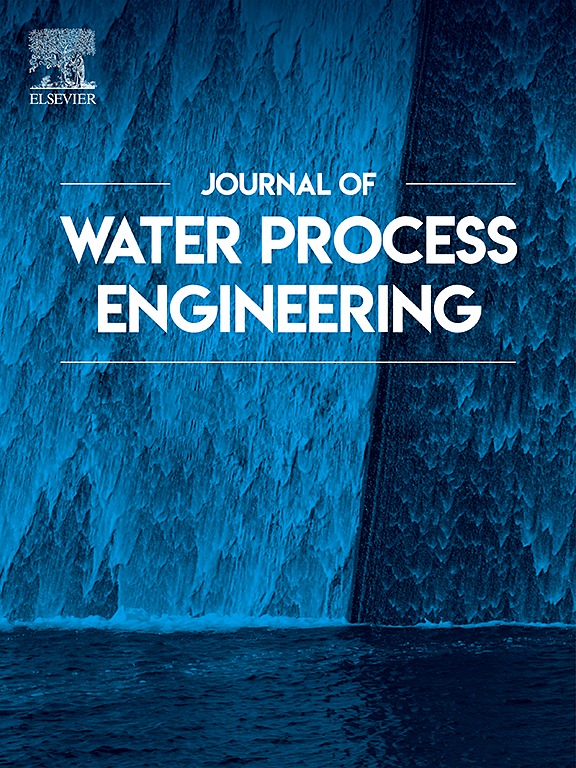Rapid spectrophotometric determination of permanganate index (CODMn) in water by 2,2′-azino-bis(3-ethylbenzothiazoline)-6-sulfonate (ABTS)
IF 6.3
2区 工程技术
Q1 ENGINEERING, CHEMICAL
引用次数: 0
Abstract
In this study, a novel and rapid spectrophotometric method for accurately measuring permanganate index (CODMn) in water samples was developed using 2,2′-azino-bis(3-ethylbenzothiazoline)-6-sulfonate (ABTS) as an indicator. Under acidic conditions, ABTS is rapidly oxidized by residual potassium permanganate in the digest solution, forming a stable green ABTS•+ radical within just 20 s. Subsequently, ABTS•+ can be accurately quantified by visible spectrophotometry at a wavelength of 415 nm. In the range of 0 to 4.46 mg/L, the absorbance change of ABTS•+ at 415 nm showed a strong linear relationship with the concentration of CODMn (R2 = 0.999). The method has high sensitivity, with a low limit of detection for CODMn of 0.010 mg/L. It is worth noting that the ABTS method is resistant to chloride ion interference and demonstrates high accuracy when applied to real water samples, with recovery rates ranging from 98.59 % to 99.93 %. Compared to the national standard titration method and other previously reported spectrophotometric methods, the ABTS method is simpler and more environmentally friendly. In conclusion, the proposed ABTS spectrophotometric method represents a promising approach for the accurate and rapid determination of CODMn in water, providing a feasible alternative to traditional methods for CODMn determination.
2,2′-氮基-双(3-乙基苯并噻唑啉)-6-磺酸盐(ABTS)快速光度法测定水中高锰酸盐指数(CODMn)
本研究以2,2′-氮基-双(3-乙基苯并噻唑啉)-6-磺酸盐(ABTS)为指示剂,建立了一种准确测定水样中高锰酸盐指数(CODMn)的新型快速分光光度法。在酸性条件下,ABTS被消化液中残留的高锰酸钾迅速氧化,在20秒内形成稳定的绿色ABTS•+自由基。随后,ABTS•+可以通过可见分光光度法在415 nm波长下精确定量。在0 ~ 4.46 mg/L范围内,ABTS•+在415 nm处的吸光度变化与CODMn浓度呈较强的线性关系(R2 = 0.999)。该方法灵敏度高,对CODMn的检测下限为0.010 mg/L。值得注意的是,ABTS方法具有抗氯离子干扰的特点,在实际水样中具有较高的准确度,回收率在98.59% ~ 99.93%之间。与国家标准滴定法和其他先前报道的分光光度法相比,ABTS方法更简单,更环保。综上所述,ABTS分光光度法为准确、快速测定水中CODMn提供了一种可行的方法,可替代传统的CODMn测定方法。
本文章由计算机程序翻译,如有差异,请以英文原文为准。
求助全文
约1分钟内获得全文
求助全文
来源期刊

Journal of water process engineering
Biochemistry, Genetics and Molecular Biology-Biotechnology
CiteScore
10.70
自引率
8.60%
发文量
846
审稿时长
24 days
期刊介绍:
The Journal of Water Process Engineering aims to publish refereed, high-quality research papers with significant novelty and impact in all areas of the engineering of water and wastewater processing . Papers on advanced and novel treatment processes and technologies are particularly welcome. The Journal considers papers in areas such as nanotechnology and biotechnology applications in water, novel oxidation and separation processes, membrane processes (except those for desalination) , catalytic processes for the removal of water contaminants, sustainable processes, water reuse and recycling, water use and wastewater minimization, integrated/hybrid technology, process modeling of water treatment and novel treatment processes. Submissions on the subject of adsorbents, including standard measurements of adsorption kinetics and equilibrium will only be considered if there is a genuine case for novelty and contribution, for example highly novel, sustainable adsorbents and their use: papers on activated carbon-type materials derived from natural matter, or surfactant-modified clays and related minerals, would not fulfil this criterion. The Journal particularly welcomes contributions involving environmentally, economically and socially sustainable technology for water treatment, including those which are energy-efficient, with minimal or no chemical consumption, and capable of water recycling and reuse that minimizes the direct disposal of wastewater to the aquatic environment. Papers that describe novel ideas for solving issues related to water quality and availability are also welcome, as are those that show the transfer of techniques from other disciplines. The Journal will consider papers dealing with processes for various water matrices including drinking water (except desalination), domestic, urban and industrial wastewaters, in addition to their residues. It is expected that the journal will be of particular relevance to chemical and process engineers working in the field. The Journal welcomes Full Text papers, Short Communications, State-of-the-Art Reviews and Letters to Editors and Case Studies
 求助内容:
求助内容: 应助结果提醒方式:
应助结果提醒方式:


